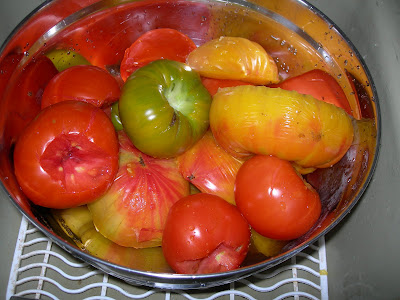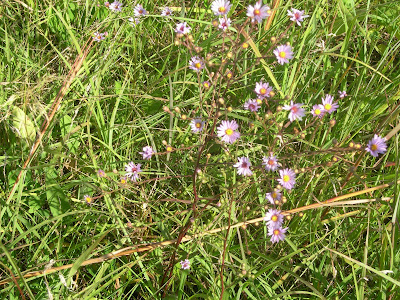I had so many ripe tomatoes, and hadalready consigned so many overripe ones to the compost pile, that I was determined to make some tomato sauce today. None of my tomatoes are the traditional sauce type, typically Romas, which are meaty and less juicy than slicers, but I figured I could still make a passable sauce.

When full, this bowl holds 24 cups. It got full. Here are most of the peeled and coarsely chopped tomatoes before going into the stock pot. It almost looks like a fruit salad. I really wasn't sure what color the sauce would end up being with so much yellow and some green tomato in the mix, though I knew it wasn't going to be a rich, dark red.
Here's a glimpse into the tall pot while the sauce was cooking; you can see that the sauce was a reddish orange with chunks of distinct red and yellow tomatoes and green and dark purple flecks of basil. I first sauteed a large yellow onion, finely chopped, and several cloves' worth of garlic paste in some olive oil. Then I added the tomatoes and several tablespoons of chopped basil (three kinds) and lemon thyme from my garden and some dried oregano, bay leaves, sea salt, and freshly ground pepper. Later I decided to add a small can of tomato paste to help it thicken up. The sauce simmered all afternoon, making Dave comment that the house smelled like his (Italian) Aunt Frances's house did in his youth -- high praise. I tried smashing all the chunks of tomato with my potato masher, but that wasn't as effective as I wanted it to be, so I later resorted to the blender to even out the texture somewhat. I pureed several batches of the sauce in the blender and returned them to the pot, thus making a thin but chunky sauce into a somewhat thicker and less chunky (but still kind of chunky) sauce. I was careful to search for and remove the large bay leaves before running the blender so shredded pieces of the tough but aromatic leaves wouldn't catch in anyone's throat.
Here was the result - more than a gallon of sauce to eat on pasta with meatballs tonight and to put away in the freezer for several more meals. Nice!


























